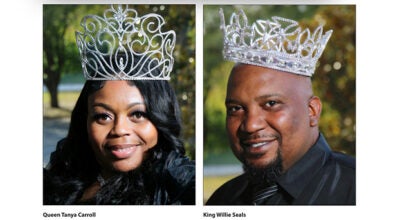Natchez organization honored as oldest nonprofit in state
Published 10:49 am Wednesday, March 28, 2012

Photos above, clockwise from top, left: Preschool teacher Spenser Rice hands out samples of peanut butter during a classroom activity. Najaylan Butler, 3, raises her hand after tasting one of the samples. Nancy Hungerford, right, has been the director of the children’s home for more than 25 years. Old photos of the Natchez Protestant Home hang in the hallway of the home. Jaivien Morgan, 4, left, and Dezarrious Johnson, 6, play around on the playground during preschool recess. Old documents serve as a reminder of the nearly 200 years the organization has been operating. (Photos by Lauren Wood \ The Natchez Democrat)
In the 1980s, board members of the Natchez Children’s Home ran into a dilemma.
The often elderly matrons hired to watch over the orphaned children were ready for bed by 9 p.m., when the teens were just getting riled up. Board members struggled to find two older women up to the task.
The system that once worked well needed some changing. And rather than throw up their hands, board members adapted to the newest trend.
Board member Kathie Blankenstein, who was appointed to the board by her church in 1970s, said leaders of the Natchez orphanage asked leaders at the Palmer Home in Columbus about the system they had in place.
“That’s when they recommended the Hungerfords,” Blankenstein said. “It was the first time we had couples (in charge), not old ladies,” Blankenstein said.
So Nancy Hungerford, who remains the executive director of NCH today, moved in with her family and took care of the children at the Children’s Home, along with her own children who grew up there.
“That was one of the big changes,” Blankenstein said.
Hungerford said perhaps the Natchez Children’s Home’s record of flexibility and adapting to the times is what has helped it survive to become the oldest nonprofit in the State of Mississippi — a recent designation by the Mississippi Secretary of State, for which the Mississippi Department of Archives and History acknowledged with a new marker outside the home’s doors.
This month marks the 196th anniversary of the children’s home’s founding.
“The needs of children and families have changed,” Hungerford said. “If we were not as flexible as those (founding) women were back in the day, we would probably not exist.”
Now the home functions as a day school and counseling resource for at-risk children ages 3 to 5.
In addition, a Child Advocacy Center recently opened at the NCH, which uses trained professionals to interview children who are victims of sexual or other types of abuse for the purpose of preparing cases for trial.
Blankenstein said few in town know about the founding members of the Natchez Children’s Home.
As the new plaque explains, on March 12, 1816 — a year before Mississippi became a state — a group of prominent women in the Natchez area founded the Female Charitable Society. Their goal was to house, educate and care for children who had been orphaned within the Mississippi Territory. The society built the Natchez Academy in 1816.
The War of 1812 had just ended, and a Yellow Fever epidemic and Indian uprisings resulted in many children becoming orphaned or abandoned.
Blankenstein said the charity originally intended only to educate those children without a place to call home, but the need to house them was soon realized.
The society began boarding the children out until 1885 when they built the Natchez Orphan Asylum, located where the present day Homochitto Street intersects with Orleans.
At one time, the children and their matron lived in a cottage on a tract of land called Boyd’s Woods near the current Arlington Plantation, but during the Civil War, the home was relocated to a house on North Union Street. The current building was erected in 1951.
Along with the changes in structure came the change of names. As the words “asylum” and “orphan” had gone out of style, the name was changed to Natchez Protestant Home, Blankenstein said.
“The need has never gone away,” Blankenstein said.
After years of serving on the board, Blankenstein learned of her own family ties with the home.
“My husband’s great-grandmother was a child here just before the Civil War,” Blankenstein said.
She said Frances Poole, her husband’s ancestor, was a little girl when her mother died and her father went off to find work and never returned. Poole’s two brothers were sent to live and work for a family in Wilkinson County, and Poole lived at the orphanage.
“I didn’t even know that when I joined (the board),” Blankenstein said.
Similarly, Blankenstein said people who once lived at the children’s home during its nearly 200 year history or had a relative who stayed there call on a regular basis to reconnect with their past or search for more information.
Recently, Blankenstein and others at the home uncovered meeting minutes from old boxes from as far back at the 1800s. While the children’s home will sell the minutes for their historical value to bring in money for the home, they requested copies to help get information for those who call seeking answers about their past, Blankenstein said.
Approximately five years ago, “reunification” with families became the standard trend for dealing with troubled children and parents, so the children’s home stopped boarding children.
“It’s hard to be flexible when you’ve done something for so long,” Blankenstein admitted.
But just like the founders did, the children’s home adapted.
Blankenstein said that in more than 30 years serving on the board, she has never come across a child who didn’t want to be reunited with his or her family, as difficult as it may be for people with the children’s home to put them back in a potentially troubled situation.
Just like the home changed to adapt to the Hungerfords in the 1980s, Hungerford adapted to her new roll as a fundraiser.
“My job is to raise a dollar and make it do the work of three,” Hungerford said.
Hungerford also attributes the longevity of the chidlren’s home to the fact that it operates on private donations instead of federal government grants, which often don’t provide long-term sustenance.
Blankenstein said it is not only the founding women or the generations upon generations of board members and employees at the children’s home that have helped it survive all these years. It is a product of the generosity of donors, both locally and nationally, that kept it alive.
For this year’s Grace McKittrick MacNeil Lecture, the Natchez Historical Society has invited Hungerford to present the story of the founding women of the Female Charitable Society. The meeting begins at 6:30 p.m. Thursday, with Hungerford’s presentation at 7 p.m. at the Natchez Convention Center. All are invited to the free event.
Pictures of eight of the founders have been located and have been incorporated into a presentation.
A portrait of the primary founder, Selah Henderson, wife of planter/merchant John Henderson, will be on display, courtesy of John and Valerie Bergeron, whose home, Pleasant Hill, was owned and lived in by Mr. and Mrs. Henderson in 1816. John Henderson was also a Presbyterian elder and one of the Founders of the Presbyterian Church in Natchez.
Also included will be a history of the services, including black and white pictures of children who lived there as far back as the 1920s.
Though the times and location have changed during the last 196 years, smiles on the children swinging on the playground or learning their manners remain a constant result of the mission of the Natchez Children’s Home Services, Hungerford said.





